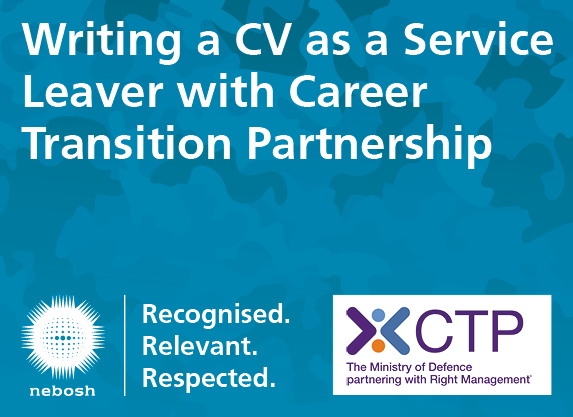Writing a CV as a Service Leaver with Career Transition Partnership
Friday, 23 June 2023
We are excited to be partnering with Career Transition Partnership on this article to bring service leavers some great tips to help them write a well-rounded CV. The Career Transition Partnership (CTP) is the Ministry of Defence working with Right Management. They are the official provider of resettlement and have supported leavers of the Armed Forces for over 20 years, as they transition from the military into civilian life.

Leaving the forces and looking for a brand-new career can be very overwhelming, especially if you’re not sure what industry you’d like to work in. A good place to start could be to begin writing your CV to see what skills you already have, that’s why we’ve partnered with The Career Transition Partnership to give you some tips on how to write a better CV.
What makes a good CV?
It needs to be well laid out and easy to read.
Your CV is a potential employer’s first impression of you. And our advice is to make your CV as easy to read as possible, which means choosing a common business font such as Ariel, Times New Roman or Verdana.
Don’t try and write a CV in one sitting – do 20 to 30 minutes’ sessions and then take a break! Don’t rush it, this is the first thing an employer could see. It’s your brand!
Employers don’t spend more than a few seconds to initially scan a CV. They don’t have time to search amongst graphics and cluttered paragraphs for the information they’re looking for. So make sure you present your CV in an organised layout. Use bullet points and keep sentences short. And pay attention to your spacing around text and between categories, as this’ll make your CV more aesthetically pleasing.
Electronically readable.
Making sure it’s internet friendly. In most cases in today’s world of work, you’ll be asked to submit your CV electronically, and so you need to make sure your CV is ‘internet friendly’.
Keep job headings simple, no need to show a map of the world listing all the countries or areas you have been to or lived in. All you need is HM Forces, job title and dates (years only)
There’s a lot of advice available around how to do this, but the best guidance is to follow the instructions given by the employer as to how they’d like to receive your CV.
Targeted to the job market.
Always ensure the content matches the vacancy or industry. Research the company and use the job advert to work out exactly what they’re looking for and how your skills align with their requirements. This’ll make it easy for the employer to scan your CV and quickly see how you’re the right fit for the role.. Try running it through TAGCROWD and see what word clouds it offers you.
Original and interesting.
Remember, be proud of your military history and how it makes you unique. Try not to edit out of your CV the fact that you’ve served as employers want you for the transferable skills you honed in the Armed Forces.
Concise and relevant.
Civilian employers are often unfamiliar with military jargon; and so you’ll need to explain in layman’s terms why the skills or achievements you list are relevant. Target your evidence to what’s being asked for in the advert. And think about what you’re transferring from your military qualifications to civilian employment.
No more than 2 pages. Employers and recruiters are very busy people and are looking for your last 10 years of work history.
Achievement based.
How can you present your experience, responsibilities and skills in a more convincing way? Achievement statements substantiate the strengths included in your profile or summary statement. Use bullet points to facilitate easy reading and try to write one or two achievements for every year in a job. Document each of your greatest strengths with at least one solid achievement/result, by using the CAR Method.
